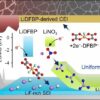Treating obese mice with the cytokine known as TSLP led to significant abdominal fat and weight loss compared to controls, according to new research published Thursday in Science from researchers in the Perelman School of Medicine at the University of Pennsylvania. Unexpectedly, the fat loss was not associated with decreased food intake or faster metabolism. Instead, the researchers discovered that TSLP stimulated the immune system to release lipids through the skin’s oil-producing sebaceous glands.
“This was a completely unforeseen finding, but we’ve demonstrated that fat loss can be achieved by secreting calories from the skin in the form of energy-rich sebum,” said principal investigator Taku Kambayashi, MD, Ph.D., an associate professor of Pathology and Laboratory Medicine at Penn, who led the study with fourth-year medical student Ruth Choa, Ph.D. “We believe that we are the first group to show a non-hormonal way to induce this process, highlighting an unexpected role for the body’s immune system.”
The animal model findings, Kambayashi said, support the possibility that increasing sebum production via the immune system could be a strategy for treating obesity in people.
The Hypothesis
Thymic stromal lymphopoietin (TSLP) is a cytokine—a type of immune system protein— involved in asthma and other allergic diseases. The Kambayashi research group has been investigating the expanded role of this cytokine to activate Type 2 immune cells and expand T regulatory cells. Since past studies have indicated that these cells can regulate energy metabolism, the researchers predicted that treating overweight mice with TSLP could stimulate an immune response, which could subsequently counteract some of the harmful effects of obesity.
“Initially, we did not think TSLP would have any effect on obesity itself. What we wanted to find out was whether it could impact insulin resistance,” Kambayashi said. “We thought that the cytokine could correct Type 2 diabetes, without actually causing the mice to lose any weight.”
The Experiment
To test the effect of TSLP on Type 2 diabetes, the researchers injected obese mice with a viral vector that would increase their bodies’ TSLP levels. After four weeks, the research team found that TSLP had not only affected their diabetes risk, but it had actually reversed the obesity in the mice, which were fed a high-fat diet. While the control group continued to gain weight, the weight of the TSLP-treated mice went from 45 grams down to a healthy 25 grams, on average, in just 28 days.
Most strikingly, the TSLP-treated mice also decreased their visceral fat mass. Visceral fat is the white fat that is stored in the abdomen around major organs, which can increase diabetes, heart disease, and stroke risk. These mice also experienced improved blood glucose and fasting insulin levels, as well as decreased risk of fatty liver disease.
Given the dramatic results, Kambayashi assumed that the TSLP was sickening the mice and reducing their appetites. However, after further testing, his group found that the TSLP-treated mice were actually eating 20 to 30 percent more, had similar energy expenditures, base metabolic rates, and activity levels, when compared to their non-treated counterparts.
The Findings
To explain the weight loss, Kambayashi recalled a small observation he had previously ignored: “When I looked at the coats of the TSLP-treated mice, I noticed that they glistened in the light. I always knew exactly which mice had been treated, because they were so much shinier than the others,” he said.
Kambayashi considered a far-fetched idea—was their greasy hair a sign that the mice were “sweating” out fat from their skin?
To test the theory, the researchers shaved the TSLP-treated mice and the controls and then extracted oils from their fur. They found that Kambayashi’s hypothesis was correct: The shiny fur contained sebum-specific lipids. Sebum is a calorically-dense substance produced by sebocytes (highly specialized epithelial cells) in the sebaceous glands and helps to form the skin barrier. This confirmed that the release of oil through the skin was responsible for the TSLP-induced fat loss.
The Conclusions
To examine whether TSLP could potentially play a role in the control of oil secretion in humans, the researchers then examined TSLP and a panel of 18 sebaceous gland-associated genes in a publicly-available dataset. This revealed that TSLP expression is significantly and positively correlated with sebaceous gland gene expression in healthy human skin.
The study authors write that, in humans, shifting sebum release into “high gear” could feasibly lead to the “sweating of fat” and weight loss. Kambayashi’s group plans further study to test this hypothesis.
“I don’t think we naturally control our weight by regulating sebum production, but we may be able to highjack the process and increase sebum production to cause fat loss. This could lead to novel therapeutic interventions that reverse obesity and lipid disorders,” Kambayashi said.
Food allergy development linked to skin exposure
More information:
Thymic stromal lymphopoietin induces adipose loss through sebum hypersecretion, Science (2021). DOI: 10.1126/science.abd2893
Provided by
Perelman School of Medicine at the University of Pennsylvania
Citation:
Mice treated with this cytokine lose weight by ‘sweating’ fat (2021, July 29)
retrieved 29 July 2021
from https://medicalxpress.com/news/2021-07-mice-cytokine-weight-fat.html
This document is subject to copyright. Apart from any fair dealing for the purpose of private study or research, no
part may be reproduced without the written permission. The content is provided for information purposes only.



